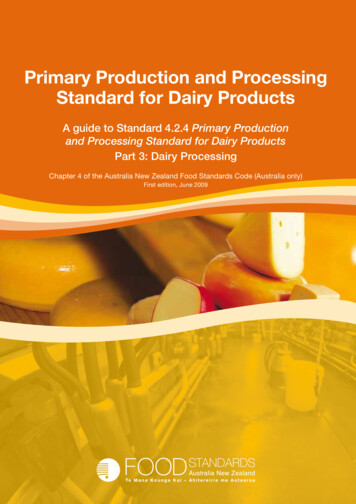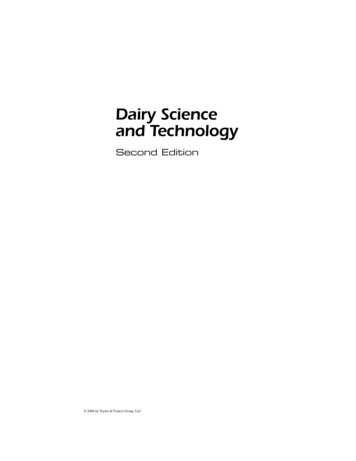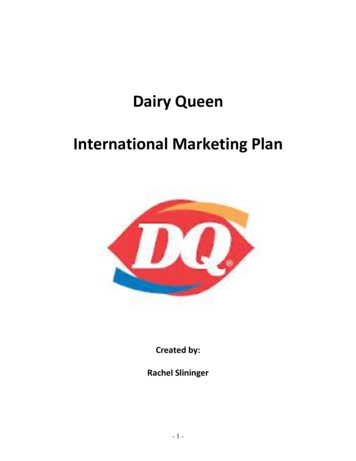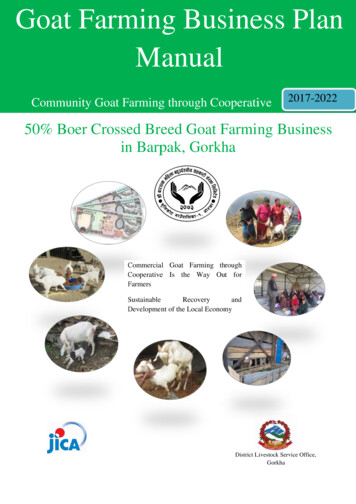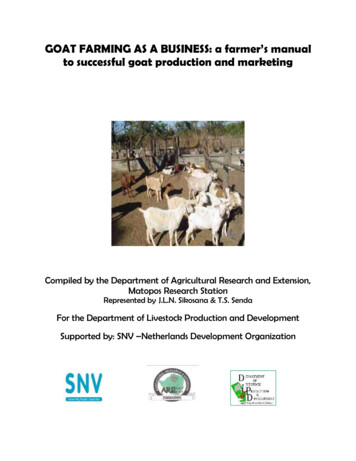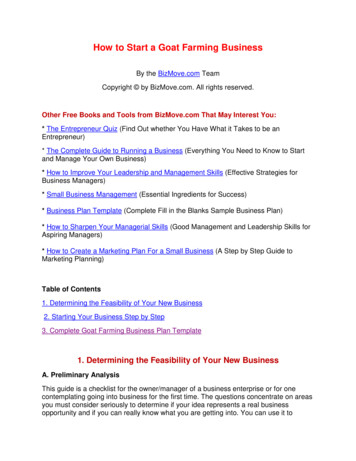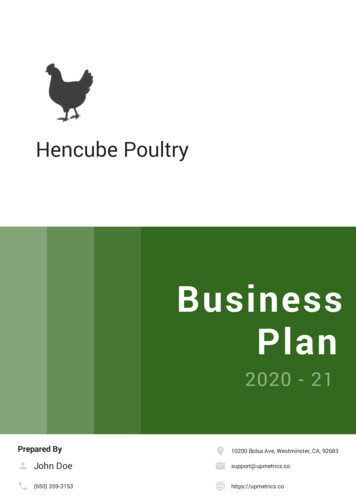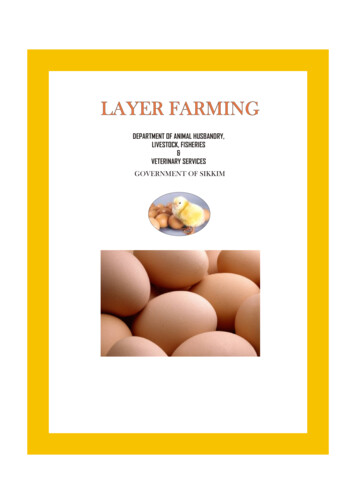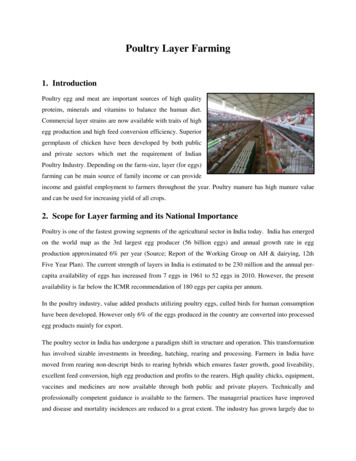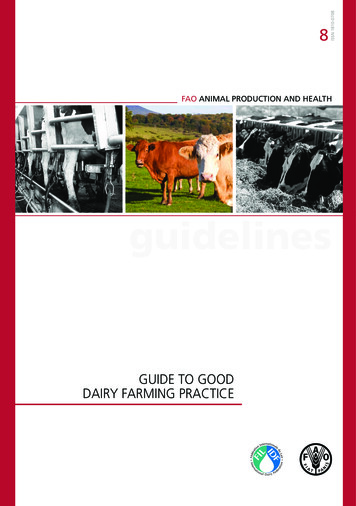
Transcription
ISSN 1810-07088FAO ANIMAL PRODUCTION AND HEALTHguidelinesGUIDE TO GOODDAIRY FARMING PRACTICE
Cover photographs:Left and center: IDFRight: FAO/Alberto Conti
8FAO ANIMAL PRODUCTION AND HEALTHguidelinesGUIDE TO GOODDAIRY FARMING PRACTICEPublished byFOOD AND AGRICULTURE ORGANIZATION OF THE UNITED NATIONSandINTERNATIONAL DAIRY FEDERATIONRome, 2011
The first edition of this guide was originally published by the Food and Agriculture Organization of the UnitedNations and the International Dairy Federation (IDF) in English as Guide to Good Dairy Farmining Practices, 2004.It is available atwww.fao.org/DOCREP/006/Y5224E/Y5224E00.htm and dfRecommended citationFAO and IDF. 2011. Guide to good dairy farming practice. Animal Production and Health Guidelines. No. 8.Rome.The designations employed and the presentation of material in this publicationdo not imply the expression of any opinion whatsoever on the part ofthe Food and Agriculture Organization of the United Nations, or of theInternational Dairy Federation (IDF) concerning the legal status of any country,territory, city or area or of its authorities, or concerning the delimitation ofits frontiers or boundaries. The mention of specific companies or products ofmanufacturers, whether or not these have been patented, does not imply thatthese have been endorsed or recommended by FAO or the IDF in preferenceto others of a similar nature that are not mentioned. The views expressed inthis information product are those of the author(s) and do not necessarilyreflect the views of FAO or the IDF.ISBN 978-92-5-106957-8All rights reserved. FAO and or IDF encourage reproduction and disseminationof material in this information product. Non-commercial uses will beauthorized free of charge, upon request. Reproduction for resale or othercommercial purposes, including educational purposes, may incur fees.Applications for permission to reproduce or disseminate FAO copyrightmaterials, and all queries concerning rights and licences, should be addressedby e-mail tocopyright@fao.org or to the Chief, Publishing Policy and Support Branch,Office of Knowledge Exchange, Research and Extension, FAO,Viale delle Terme di Caracalla, 00153 Rome, Italy. FAO and IDF, 2011 (this revised edition) FAO and IDF, 2004 (original edition)
1A basis in Good Agricultural Practice (GAP)1About this guide1Objective and scope2Other references of relevance2How the guidelines are presented3Good dairy farming practices51. Animal health52. Milking hygiene63. Nutrition (feed and water)74. Animal welfare85. Environment6. Socio-economic managementFact sheets910111. Animal health112. Milking hygiene173. Nutrition (feed and water)214. Animal welfare255. Environment306. Socio-economic management34
vForewordDairy farmers’ production systems worldwide need to be able to combine profitability withthe responsibility of protecting human health, animal health, animal welfare and the environment. Dairy farmers, as the primary producers in the supply chain, should also be giventhe opportunity to add value to their product by adopting methods of production that satisfythe demands of processors and customers.This Guide gives individual dairy farmers proactive guidance on how these objectives canbe achieved on their farm.The Guide to good dairy farming practice has been written in a practical format fordairy farmers engaged in the production of milk from any dairy species. When adopted, itwill support the production and marketing of safe, quality-assured milk and dairy products.The Guide focuses on the relationship between consumer safety and economic, social andenvironmental management at the farm level.The Guide contains many individual practices that contribute to good dairy farmingpractice, covering the key aspects of animal health, milk hygiene, nutrition, welfare, theenvironment and socio-economic management.These practices have been drawn from best practice guidelines and existing assuranceschemes around the world, and so individual practices will vary in their applicability to various dairying regions. They are not intended to be legally binding and readers are encouragedto select and implement those guidelines that are of relevance to their situation.As such, this Guide aims to provide a genuine framework for dairy farm assuranceschemes to be developed globally, giving individual countries and dairy farmers the opportunity to develop schemes that are specific to their needs.MISSION STATEMENTTo elaborate a practical, farm orientated, globally achievable Guide to good dairy farming practices for dairy farmers, covering key aspects of dairy farm management including:animal health, milk hygiene, animal nutrition, animal welfare, the environment and socioeconomic management.Helen DornomChairIDF/FAO Project Group of theIDF Standing Committee onFarm ManagementBerhe G. TekolaDirectorAnimal Production and Health DivisionFood and Agriculture Organization ofthe United Nations
viiAcknowledgementsThis new Guide updates the first edition produced by the IDF/FAO Task Force on Good DairyFarming Practices in 2004.The IDF/FAO Project Group of the IDF Standing Committee on Farm Management included the following experts: Helen Dornom (AU) - Chair, Réjean Bouchard (CA), Jude Capper(US), J Eric Hillerton (NZ), David Homer (GB), Eirini Fragkiadaki (GR), Jamie Jonker (US),Cheryl McCrindle (ZA), Marie Natacha (FR), Marcin Preidl (DE), M U Siddiqui (IN), Olaf Thieme(FAO) and Yong-Suk Son (KR). The group was supported by other IDF experts who made anactive contribution to the work: Elizabeth Berry (GB), Olivier Cerf (FR), Robin Condron (AU),Elisabeth Erlacher-Vindel (OIE), Ham Junsang (KR), Mohan Namjoshi (IN), Daniel Scholl (CA),Joerg Seifert (IDF), Rafal Artur Stachura (PL) and Vincent Turner (ZA).Special thanks must be given to Helen Dornom (AU) assisted by Robert Greenall (AU)for compiling the information into a coherent document. Thanks also go to Pierre Doyle ofFIL-IDF Canada and Thierry Geslain of FIL-IDF France for ensuring the translation of the document from English to French and to Pedro Valentin-Gamazo of IDF Spain for taking charge ofthe translation into Spanish. The FAO Animal Production and Health Division (AGA) arrangedtranslation into other official working languages of FAO and the publication of the Guide.
1IntroductionA BASIS IN GOOD AGRICULTURAL PRACTICE (GAP)Good Agricultural Practice for dairy farmers is about implementing sound practices on dairyfarms – collectively called Good Dairy Farming Practice.These practices must ensure that the milk and milk products produced are safe and suitable for their intended use, and also that the dairy farm enterprise is viable into the future,from the economic, social and environmental perspectives.Most importantly, dairy farmers are in the business of producing food for human consumption so they must be confident in the safety and quality of the milk they produce.Good dairy farming practice underpins the production of milk that satisfies the highestexpectations of the food industry and consumers.The international framework to ensure the safety and suitability of milk and milk products is contained in the Codex Recommended International Code of Practice - GeneralPrinciples of Food Hygiene (CAC/RCP 1- 1969, Rev. 4, 2003)1 together with the CodexCode of Hygienic Practice for Milk and Milk Products (CAC/RCP 57-2004)2. This Guidepicks up the principles within these documents that relate to the production of milk onfarms. It recognises that dairy farmers are an integral part of a larger dairy food production and processing chain and that all participants in the chain - dairy farmers, suppliers todairy farmers, milk carriers and haulers, dairy product and food manufacturers, distributors,retailers and consumers - should be part of an integrated food safety and quality assurancemanagement system. Dairy farmers can play their part by ensuring that good dairy farmingpractices are implemented at the farm level.Good dairy farming practice also ensures that the milk is produced by healthy animalsin a manner that is sustainable and responsible from the animal welfare, social, economicand environmental perspectives. So implementing good dairy farming practice is good riskmanagement for the short and long term future of the dairy farming enterprise. This Guideencourages dairy farmers to adopt ‘proactive’ preventative practices rather than waiting forproblems to occur.In summary, this Guide details Good Agricultural Practice (GAP) for dairy farmers, underpinning the production of safe, quality-assured dairy products in a sustainable manner thatunderpins the future of dairy farming on a local, national and international scale.12Recommended International Code of Practice – General Principles of Food Hygiene, CAC/RCP 1 – 1969. Availableat www.codexalimentarius.netCode of Hygienic Practice for Milk and Milk Products, CAC/RCP 57 - 2004. Available at www.codexalimentarius.net
Guide to good dairy farming practice2ABOUT THIS GUIDEMany dairy companies/cooperatives and countries have introduced on-farm safety andquality assurance programmes aimed at assuring the safety and quality of their dairy products.The objective of this document is to provide a farmer-orientated guide to practices thatare achievable in the diverse range of dairy farming systems used around the world. Theapproach taken in this guide is to: highlight relevant aspects that need to be proactively managed on dairy farms; identify the desired outcomes in dealing with each of these areas; specify good practice that addresses the critical hazards; and provide examples of control measures that should be implemented to achieve theobjectives.This Guide is intended as a resource for dairy farmers, to be used or implemented ina way that is relevant to their particular farming system. The focus is on the desired outcomes, rather than on specific, prescriptive actions/processes. The guide does not have anylegal status and does not supersede national or international requirements.OBJECTIVE AND SCOPEThe guiding objective for good dairy farming practice is that safe, quality milk should beproduced from healthy animals using management practices that are sustainable from ananimal welfare, social, economic and environmental perspective.To achieve this objective, dairy farmers should apply good practice in the followingareas: animal health; milking hygiene; nutrition (feed and water); animal welfare; environment; and socio-economic management.For each of these categories this Guide lists good dairy farming practices, and suggestsmeasures that can be implemented to achieve the desired outcome.OTHER REFERENCES OF RELEVANCEIn developing this Guide, reference was made to a number of sources; including international publications from Codex Alimentarius (CODEX), Food and Agriculture Organisationof the United Nations (FAO), International Dairy Federation (IDF), World Organisation forAnimal Health (OIE), Sustainable Agriculture Initiative (SAI) as well as a number of on-farmassurance programmes from various countries.In particular, when developing individual, company or country-specific guidelines forgood dairy farming practices (or on-farm quality assurance programmes), reference shouldbe made to the following documents: Codex Alimentarius: Food Hygiene - The Basic Texts (4th ed)3. Codex Alimentarius: Recommended International Code of Practice – General Principles of Food Hygiene CAC/RCP 1 – 19693.
Introduction3 Codex Alimentarius: Code of Hygienic Practice for Milk and Milk Products CAC/RCP57 - 20043. Codex Alimentarius: Code of Practice on Good Animal Feeding CAC/RCP 54-20043. FAO: Food Quality and Safety Systems – A training manual on food hygiene and theHazard Analysis and Critical Control Point (HACCP) system (1998)4. OIE: Terrestrial Animal Health Code5. SAI Platform: Principles and Practices for Sustainable Dairy farming (2009)6.HOW THE GUIDELINES ARE PRESENTEDThe Guidelines are presented in two forms:1. Good dairy farming practices and suggested measures are set out in tabular formfor each key area: animal health, milking hygiene, animal nutrition, animal welfare,environment and socio-economic management.2. Individual Fact Sheets are provided for each area giving further details on how toimplement the good dairy farming practices.Guiding objectives forgood dairy farming practicesMain ObjectiveSafe, quality milk is produced from healthy animals using management practices that aresustainable from an animal welfare, social, economic and environmental perspectiveGood practicesAnimalHealthMilkingHygieneNutrition(Feed &Water)AnimalWelfareDefining lableat www.codexalimentarius.netfrom www.fao.orgfrom www.oie.intfrom ent
5Good dairy farming practices1. ANIMAL HEALTHAnimals that produce milk need to be healthy and an effective health care programmeshould be in place.Good dairyfarming practiceExamples of suggested measures to achievegood dairy farming practiceObjectives of these measures1.1 Establish theherd withresistance todisease1.1.1 Choose breeds and animals well suited to the localenvironment and farming systemEnhance herd diseaseresistance / reduce stress1.1.2 Determine herd size and stocking rate based onmanagement skills, local conditions and the availabilityof land, infrastructure, feed, and other inputs1.1.3 Vaccinate all animals as recommended or required bylocal animal health authorities1.2 Prevent entry ofdisease onto thefarm1.2.1 Only buy animals of known health status (both herdand individual animals) and control their introductionto the farm using quarantine if indicated1.2.2 Ensure animal transport on and off the farm does notintroduce disease1.2.3 Monitor risks from adjoining land and neighbours andhave secure boundarie
It recognises that dairy farmers are an integral part of a larger dairy food produc-tion and processing chain and that all participants in the chain - dairy farmers, suppliers to dairy farmers, milk carriers and haulers, dairy product and food manufacturers, distributors, retailers and consumers - should be part of an integrated food safety and quality assurance management system. Dairy .File Size: 659KBPage Count: 50


